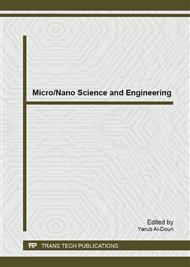p.13
p.18
p.23
p.28
p.33
p.38
p.43
p.48
p.52
Enhanced Photoconductivity and Antibacterial Response of Rubber-Grade ZnO upon UVA Illumination
Abstract:
Ultraviolet-A (UVA) radiation is present in sunlight and have been associated with various types of human skin cancers. In this study, rubber-grade zinc oxide (ZnO) powder was used as the targeted materials to study its UVA photoresponse as well as its antibacterial function. ZnO powder was synthesized using French process. The morphological structures of the samples were investigated using field emission scanning electron microscopy and transmission electron microscopy. The dominant morphology of the sample was micro/nanoplate. The optical bandgap of the ZnO sample is 3.19 eV based on the UV-Visible measurement. Current-voltage measurement was conducted to study the effect of UVA (390 nm) illumination on the photoconductivity of the ZnO pellet. Photoconductivity was observed to increase significantly under UVA exposure due to light absorption on the surface of ZnO to raise the electrons across the bandgap. The current response of the UVA-induced also revealed the small persistent photoconductivity after the UVA light was turned off. Besides, higher voltage bias would lead to higher current flow under the same intensity of UVA exposure. According to the antibacterial test towards Staphylococcus aureus, the percentage inhibition of the bacterial after 24 h incubation increase when the concentration of ZnO suspension increases. The UVA illumination had improved the inhibition of the bacterial growth. This is due to the excitation of ZnO and increasing of free charge carriers in the solution, leading to potential distortion to the membrane surface of the bacteria. ZnO powder performed high absorption of UVA and they are not only can be used to block the UVA sunlight, but also have higher antibacterial capability under UVA excitation.
Info:
Periodical:
Pages:
33-37
Citation:
Online since:
April 2014
Keywords:
Price:
Сopyright:
© 2014 Trans Tech Publications Ltd. All Rights Reserved
Share:
Citation:


